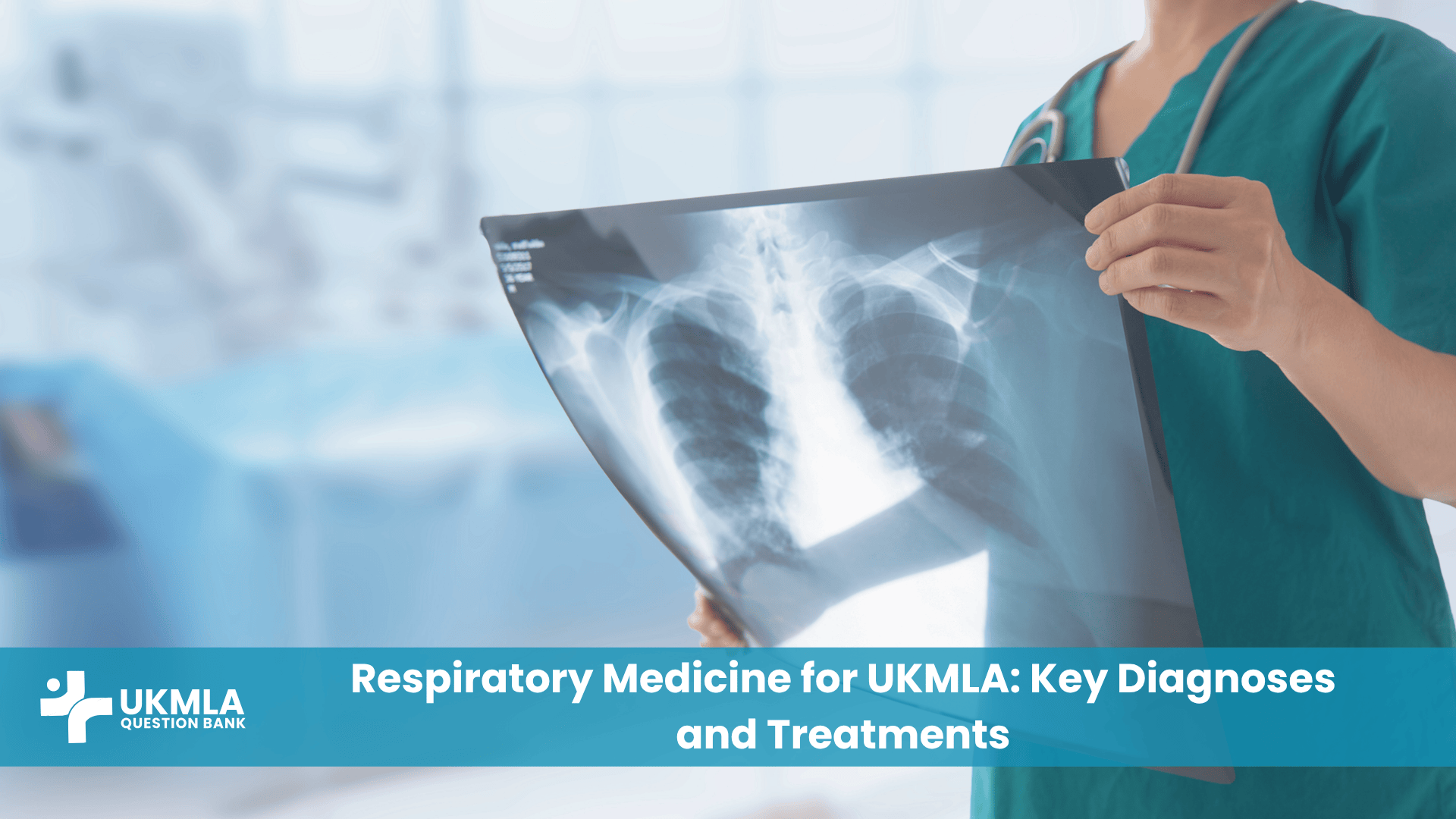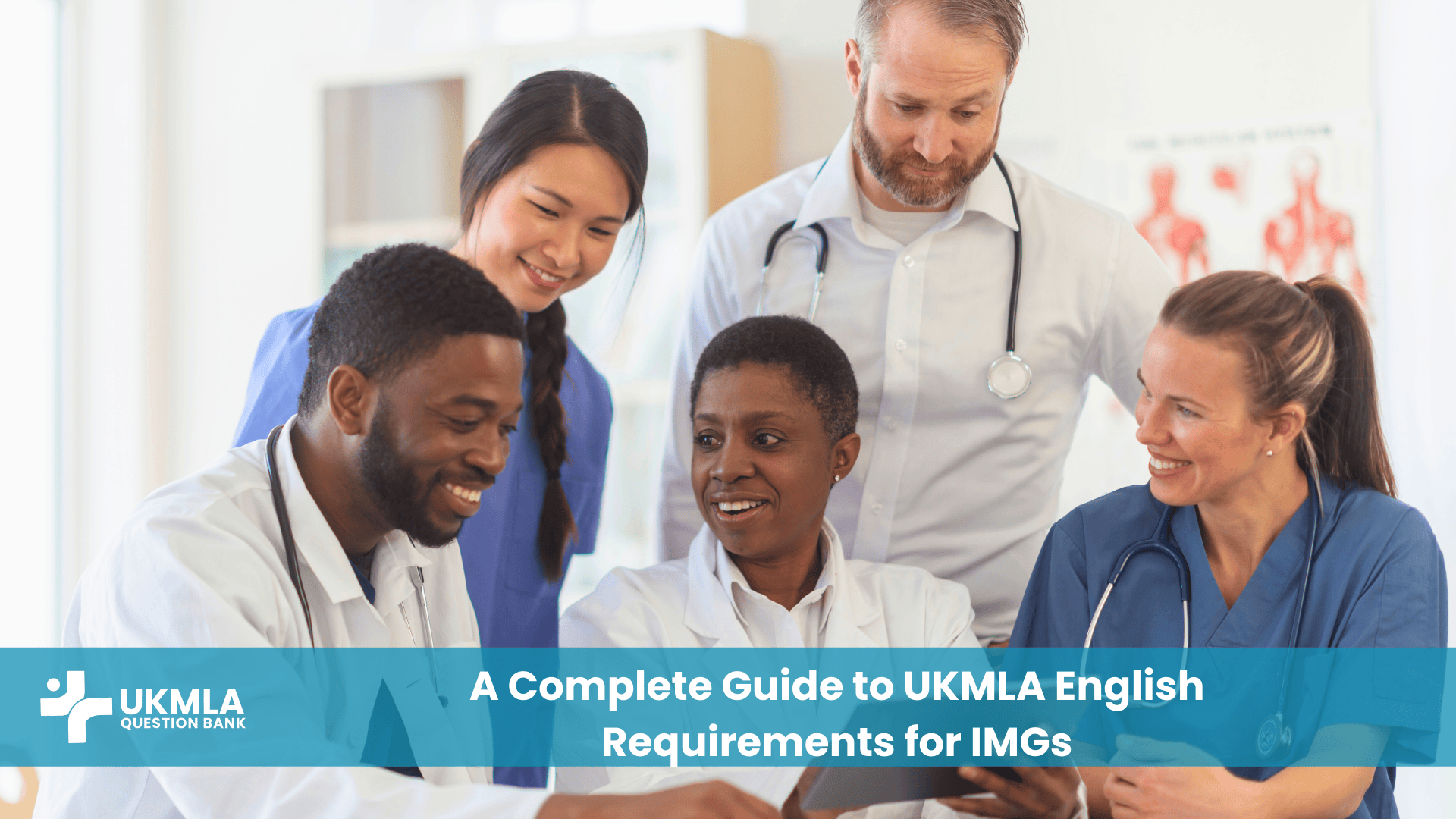Respiratory medicine represents a vast and fundamental pillar of clinical practice in the United Kingdom. It is, without question, a high-yield and critically important subject for the UKMLA Applied Knowledge Test (AKT). From the chronic cough in a GP clinic to the acutely breathless patient in A&E, respiratory conditions are pervasive and frequently urgent. A comprehensive understanding of UKMLA respiratory medicine is therefore essential, not only to achieve a high score but to ensure you are a safe and competent doctor from day one.
This guide is designed to provide a strategic and focused approach to mastering UKMLA respiratory medicine. We will concentrate on the key diagnoses and treatments you are most likely to face in the exam, covering the spectrum from chronic obstructive diseases to life-threatening emergencies. By breaking down the essential pathophysiology, diagnostic pathways, and evidence-based management of these conditions, you will build a solid framework for success. This will allow you to tackle any respiratory SBA question with confidence and precision.
Key Takeaways
Before we delve into the details of UKMLA respiratory medicine, here are the most critical takeaways for your revision:
- Prioritize the Common: Focus the majority of your study time on asthma, COPD, and community-acquired pneumonia. These are the bread-and-butter of respiratory medicine.
- Master the Emergencies: Have an ironclad knowledge of the immediate management of acute severe asthma, tension pneumothorax, and pulmonary embolism.
- Learn Your Scores: Be able to calculate and apply the CURB-65 score for pneumonia severity and the Wells’ score for PE probability.
- Know the Red Flags: Recognizing the red flag symptoms for lung cancer and understanding the urgent two-week-wait referral pathway is a critical safety issue.
- Understand Basic Investigations: Be confident in interpreting basic spirometry (obstructive vs. restrictive patterns), peak flow diaries, and common chest X-ray findings.
- Inhaler Pharmacology is Key: Know the different classes of inhalers (SABA, LABA, ICS, LAMA, SAMA) and their specific roles in the stepwise management of asthma and COPD.
- Practice, Practice, Practice: Use a high-quality question bank to repeatedly test your knowledge and application of UKMLA respiratory medicine concepts in a clinical context.
The High-Yield Nature of UKMLA Respiratory Medicine
The UKMLA AKT is designed to reflect real-world clinical practice in the UK, and respiratory conditions are a major part of that reality. Understanding why this topic is so heavily weighted will help you appreciate the importance of your revision.
The Clinical Burden of Respiratory Disease
Respiratory illnesses, from asthma to lung cancer, are a leading cause of morbidity and mortality and account for a huge proportion of NHS activity. As a Foundation Year 1 doctor, you will be constantly assessing and managing patients with respiratory symptoms. The UKMLA’s primary goal is to ensure you are ready for this responsibility. A strong command of UKMLA respiratory medicine is a direct reflection of your readiness for safe practice.
Data Interpretation in Respiratory Questions
Respiratory medicine is rich with opportunities for data interpretation within SBA questions. You will not just be asked to recall facts; you will be asked to apply them. Be prepared for vignettes that include:
- Spirometry results
- Peak flow readings
- Arterial blood gas (ABG) analysis
- Chest X-ray descriptions or images
Your ability to synthesize this data with the clinical history is a key skill. We cover the art of dissecting these questions in our guide, “UKMLA AKT: How to Tackle Single Best Answer (SBA) Questions Effectively“.
The Importance of the UKMLA Content Map
To ensure your study is focused, you must use the official exam blueprint. Our article, “How to Use the GMC UKMLA Content Map to Structure Your Revision,” is an essential read. The content map explicitly lists key presentations like “Breathlessness,” “Cough,” and “Haemoptysis,” all of which are central to UKMLA respiratory medicine. Aligning your revision with this document ensures you are studying what matters most.
Obstructive Airway Diseases: The Core of Respiratory Medicine
Asthma and COPD are the two most important chronic conditions in UKMLA respiratory medicine. A deep understanding of their differences, stable management, and acute exacerbations is vital.
Asthma: Stepwise Control and Acute Management
Asthma is a chronic inflammatory disease characterized by reversible bronchoconstriction. For the UKMLA, you must know:
- Diagnosis: Based on a history of episodic symptoms (wheeze, cough, dyspnoea) and demonstrating variability or reversibility with spirometry or peak flow diaries.
- Stepwise Management: The BTS/SIGN guideline is the gold standard in the UK. You must know the management ladder, from SABA-only use to the addition of ICS, LABAs, and other advanced therapies.
- Acute Severe Asthma: Recognizing a life-threatening attack is a critical safety skill. Know the signs (e.g., silent chest, inability to complete sentences) and the immediate management protocol (O-S-A-M-E: Oxygen, Salbutamol, Hydrocortisone, Ipratropium, Magnesium/Escalate). The complete BTS/SIGN Asthma Guideline is the authoritative source.
COPD: Stable State and Acute Exacerbations
Chronic Obstructive Pulmonary Disease (COPD) is a progressive, non-reversible airflow obstruction primarily caused by smoking.
- Diagnosis: Requires a history of progressive breathlessness in a smoker/ex-smoker, confirmed with post-bronchodilator spirometry showing an FEV1/FVC ratio < 0.7.
- Stable Management: The cornerstones are smoking cessation and pulmonary rehabilitation. Pharmacological management involves a stepwise use of SAMA/SABA, LAMA, LABA, and sometimes ICS for frequent exacerbators.
- Acute Exacerbation (AECOPD): Presents with an acute worsening of symptoms. Management involves controlled oxygen (target sats 88-92%), nebulized bronchodilators, oral corticosteroids, and antibiotics if the sputum is purulent.
Differentiating Asthma from COPD
A common exam question will require you to differentiate between these two obstructive diseases.
| Feature | Typically Asthma | Typically COPD |
|---|---|---|
| Age of Onset | Usually childhood or young adulthood | Typically over 40 years old |
| Smoking History | Variable, not a primary cause | Almost always a significant smoking history |
| Symptom Pattern | Episodic, diurnal variability, often has triggers | Persistent and progressively worsening |
| Spirometry | Demonstrates significant bronchodilator reversibility | Largely irreversible airflow obstruction |
Respiratory Infections and Malignancy
Infections are a major component of acute medicine, and recognizing lung cancer is a key professional responsibility. Both are central to UKMLA respiratory medicine.
Community-Acquired Pneumonia (CAP)
CAP is an acute infection of the lung parenchyma. For the UKMLA, you must master its assessment.
- Diagnosis: Based on symptoms (cough, fever, purulent sputum), signs (focal chest crackles), and supported by a chest X-ray.
- Severity Assessment: The CURB-65 score is an essential tool you must be able to apply. It determines mortality risk and guides the location of treatment (home, hospital, or ICU).
“The CURB-65 score is not just a tool for exams; it is used every single day on medical admission units across the UK. Knowing it is fundamental to making safe and appropriate decisions for patients with pneumonia.” – (Attributed to an Acute Medicine Consultant).
| CURB-65 Score Component | Points |
|---|---|
| Confusion (new disorientation, AMTS ≤ 8) | 1 |
| Urea > 7 mmol/L | 1 |
| Respiratory Rate ≥ 30 breaths/min | 1 |
| Blood Pressure (SBP < 90 mmHg or DBP ≤ 60 mmHg) | 1 |
| Age ≥ 65 years | 1 |
| Score 0-1: Low severity, consider home treatment. Score 2: Moderate severity, consider hospital admission. Score ≥3: High severity, urgent hospital admission. | |
Lung Cancer and Urgent Referral
Recognizing the potential signs of lung cancer is a critical safety aspect of UKMLA respiratory medicine.
- Red Flag Symptoms: Be vigilant for haemoptysis, unexplained persistent cough, unexplained weight loss, finger clubbing, and persistent hoarseness.
- Referral Pathway: You must know the criteria for an urgent two-week-wait (2WW) referral for suspected cancer. The NICE guideline on suspected cancer referral is the official document outlining these pathways. Highlight: A chest X-ray finding suggestive of lung cancer mandates an urgent 2WW referral.
Vascular and Pleural Disease
This category includes some of the most dramatic and life-threatening respiratory emergencies.
Pulmonary Embolism (PE)
A PE is a blockage in the pulmonary artery, usually from a dislodged deep vein thrombus (DVT).
- Presentation: Can range from subtle pleuritic chest pain to sudden collapse. Look for risk factors (e.g., recent surgery, immobility, cancer) and signs of DVT.
- Diagnostic Pathway: This is a crucial algorithm to learn. It starts with the Wells’ score to stratify clinical probability. If ‘unlikely,’ a D-dimer test is used as a rule-out. If ‘likely’ or the D-dimer is positive, the next step is a CT Pulmonary Angiogram (CTPA) for definitive diagnosis.
- Management: Immediate therapeutic anticoagulation is required.
Pneumothorax and Pleural Effusion
- Pneumothorax: Air in the pleural space. A simple pneumothorax may be managed conservatively, but a tension pneumothorax (with tracheal deviation and cardiovascular compromise) is a medical emergency requiring immediate needle decompression.
- Pleural Effusion: Fluid in the pleural space. Key exam findings are a “stony dull” percussion note and reduced breath sounds. Understanding the causes of a transudate (e.g., heart failure) versus an exudate (e.g., infection, malignancy) is high-yield.
| Condition | Key Differentiator | Immediate Action |
|---|---|---|
| Acute Severe Asthma | History of asthma, widespread wheeze (or silent chest), reversible component. | Oxygen, high-dose nebulized bronchodilators, systemic steroids. |
| Tension Pneumothorax | Tracheal deviation AWAY from affected side, unilateral absent breath sounds, hypotension. | Immediate needle decompression in the 2nd intercostal space, mid-clavicular line. |
| Massive Pulmonary Embolism | Risk factors for VTE, signs of circulatory collapse (hypotension, tachycardia). | ABCDE approach, high-flow oxygen, consider thrombolysis. |
Supercharge Your UKMLA Prep with UKMLAQuestionBank.com
Mastering the breadth of UKMLA respiratory medicine requires more than just reading; it demands active practice. UKMLAQuestionBank.com is the ultimate resource to help you apply your knowledge and hone your exam technique.
Our extensive UKMLA question bank is filled with high-yield, clinically-oriented SBAs that mirror the style and difficulty of the real exam. We provide detailed, expert-written explanations that help you understand the nuances of each topic, from interpreting spirometry to choosing the right antibiotic for pneumonia based on the CURB-65 score.
With UKMLAQuestionBank.com, you get:
- Exam-Relevant Scenarios: Practice with hundreds of vignettes covering all key aspects of UKMLA respiratory medicine.
- Data Interpretation Practice: Sharpen your skills with questions that incorporate ECGs, ABGs, and chest X-ray findings.
- Performance Analytics: Identify your strengths and weaknesses within respiratory medicine so you can focus your revision effectively.
- 24/7 Access: Our flexible platform allows you to fit high-quality practice into your busy schedule.
Frequently Asked Questions (FAQ) on Your UKMLA Respiratory Medicine Questions Answered
Very important. You should know the first-line choices for low, moderate, and high-severity CAP according to local or national guidelines (e.g., amoxicillin for low severity, amoxicillin + clarithromycin for moderate/high severity).
While possible, it’s a lower-yield topic than the core conditions. For sarcoidosis, the key things to know are that it can present with bilateral hilar lymphadenopathy on a chest X-ray and a raised serum ACE level.
No. As a junior doctor, your role is to suspect the diagnosis based on red flags and make the appropriate urgent referral. Detailed staging (TNM) is a specialist topic.
This is a fundamental concept. Type 1 is hypoxia (low PaO₂) with normal or low PaCO₂. Type 2 is hypoxia (low PaO₂) with hypercapnia (high PaCO₂), indicating inadequate ventilation.
While helpful, it’s more important to know the drug classes (e.g., SABA, ICS, LAMA) and their mechanism of action than to memorize every brand name and colour. The generic drug name will always be provided in the exam.
It is moderately high-yield. You should be able to recognize the classic presentation of Obstructive Sleep Apnoea (OSA) – a patient (often obese) with daytime somnolence, snoring, and witnessed apnoeic episodes. The Epworth Sleepiness Scale is the key screening tool.
A pneumothorax is air in the pleural space, leading to a hyper-resonant percussion note. A haemothorax is blood in the pleural space, leading to a “stony dull” percussion note, similar to an effusion.
You will most likely be given the key values (FEV1, FVC, and the FEV1/FVC ratio) and asked to interpret them as either an obstructive, restrictive, or normal pattern). You won’t need to interpret complex data like gas transfer.
Yes, know the basic criteria for offering LTOT in stable COPD patients – typically when their PaO₂ is persistently low (<7.3 kPa) despite optimal medical therapy.
Combine focused reading with active learning. After studying a topic like asthma, immediately do 15-20 practice questions on it to solidify your knowledge. Using a structured plan, such as the one described in “Creating the Perfect UKMLA Study Plan: A 3-Month Template,” can keep you on track.
Conclusion: Building Confidence in UKMLA Respiratory Medicine
The field of UKMLA respiratory medicine is vast, but your revision can be targeted and highly effective. By concentrating on the high-yield essentials—obstructive diseases, common infections, vascular emergencies, and the red flags of malignancy—you will be well-prepared for what the UKMLA AKT has to offer. Use the official content map to guide your studies, practice interpreting clinical data, and commit the key management algorithms to memory.
A strong, systematic approach to respiratory medicine will not only translate into a higher exam score but will also equip you with the skills and confidence needed to be a safe and effective doctor on your first day of practice.
Ready to master UKMLA respiratory medicine? Turn knowledge into marks with targeted practice questions that mimic the real exam. Explore the comprehensive resources at UKMLAQuestionBank.com and take your preparation to the next level!
Breathe Easier on Exam Day: Conquer UKMLA Respiratory Medicine!
Don’t let respiratory questions leave you breathless. Access high-yield notes, exam-style SBAs, and proven strategies designed to help you ace the respiratory component of the UKMLA AKT.
[Explore Our UKMLA Respiratory Resources Now!]



